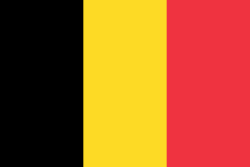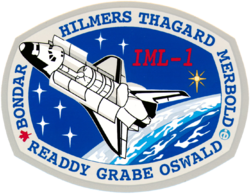STS-45
| Missionsemblem | |||||
|---|---|---|---|---|---|
 | |||||
| Missionsstatistik | |||||
| Missionsnavn: | STS-45 | ||||
| Rumagentur: | NASA | ||||
| Rumfærge: | Atlantis (11) | ||||
| Antal besætningsmedlemmer: | 7 | ||||
| Affyringsrampe: | LC-39A (KSC) | ||||
| Opsendelse: | 24. marts 1992 | ||||
| Landing: | 2. april 1992 | ||||
| Landet på: | Kennedy Space Center | ||||
| Varighed: | 8 døgn og 22 timer | ||||
| Foto af besætningen | |||||
 | |||||
| Navigation | |||||
| |||||
STS-45 (Space Transportation System-45) var rumfærgen Atlantis 11. rumfærge-mission. Den blev opsendt d. 24. marts 1992 og vendte tilbage den 2. april 1992.
Missionens primære nyttelast var Spacelab modulet med Atmospheric Laboratory for Applications and Science (ATLAS-1) der indeholdt yderligere materiale til rumforskning.
Hovedartikler:
Besætning

 Charles Bolden (kaptajn)
Charles Bolden (kaptajn)
 Brian Duffy (pilot)
Brian Duffy (pilot)
 Kathryn Sullivan (1. missionsspecialist)
Kathryn Sullivan (1. missionsspecialist)
 David Leestma (2. missionsspecialist)
David Leestma (2. missionsspecialist)
 Michael Foale (3. missionsspecialist)
Michael Foale (3. missionsspecialist)
 Byron Lichtenberg (1. nyttelast-specialist)
Byron Lichtenberg (1. nyttelast-specialist)
 Dirk Frimout (2. nyttelast-specialist) ESA
Dirk Frimout (2. nyttelast-specialist) ESA
Missionen
Missionen medbragte følgende nyttelast:
- Atmospheric Laboratory for Applications and Science (ATLAS-1)
- Atmospheric Trace Molecule Spectroscopy (ATMOS);
- Grille Spectrometer;
- Millimeter Wave Atmospheric Sounder (MAS);
- Imaging Spectrometric Observatory (ISO);
- Atmospheric Lyman-Alpha Emissions (ALAE);
- Atmospheric Emissions Photometric Imager (AEPI);
- Space Experiments with Particle Accelerators (SEPAC);
- Active Cavity Radiometer (ACR);
- Measurement of Solar Constant (SOLCON);
- Solar Spectrum (SOLSPEC);
- Solar Ultraviolet Spectral Irradiance Monitor (SUSIM);
- Far Ultraviolet Space Telescope (FAUST)
- Shuttle Solar Backscatter Ultraviolet (SSBUV)
- Get-away Special (GAS)
Eksterne henvisninger
- STS-45 NASA (engelsk)
- STS-45 Arkiveret 30. november 2013 hos Wayback Machine NASA KSC (engelsk)
| ||||||||
Medier brugt på denne side
Forfatter/Opretter: Kwamikagami, Licens: CC BY-SA 4.0
symbol of Mars. 16 × 16 pixel nominal dimensions, lines 2 pixel thick, square caps. Colour 75% blue: red=0 green=0 blue=191 (#0000BF).
Space Shuttle Atlantis takes flight on its STS-27 mission on December 2, 1988, 9:30 a.m. EST, utilizing 375,000 pounds thrust produced by its three main engines. The STS-27 was the third classified mission dedicated to the Department of Defense (DoD). After completion of mission, Orbiter Atlantis landed December 6, 1988, 3:36 p.m. PST at Edwards Air Force Base, California.
As the sun rises the morning of April 2, it casts a rosy glow over a steller performer, the orbiter Atlantis parked on Runway 33 of the Shuttle Landing Facility. Atlantis touched down at 6:23:6 a.m. EST, completing a highly successful flight that was extended by a day to further the scientific research being performed on the Atmospheric Laboratory for Applications and Science-1 (ATLAS-1) payload. On board OV-104 for Mission STS-45 was a crew of seven.
STS-49 Patch
- STS-49 Endeavour, Orbiter Vehicle (OV) 105, crew insignia (logo), the official insignia of the NASA STS-49 mission, captures space flight's spirit of exploration which has its origins in the early seagoing vessels that explored the uncharted reaches of Earth and its oceans. The ship depicted on the patch is HMS Endeavour, the sailing vessel which Captain James Cook commanded on his first scientific expedition to the South Pacific. Just as Captain Cook engaged in unprecedented feats of exploration during his voyage, on Endeavour's maiden flight, its crew will expand the horizons of space operations with an unprecedented rendezvous and series of three space walks. During three consecutive days of extravehicular activity (EVA), the crew will conduct one space walk to retrieve, repair and deploy the INTELSAT IV-F3 communications satellite, and two additional EVAs to evaluate the potential Space Station Freedom (SSF) assembly concepts. The flags flying on Endeavour's masts wear the colors of the two schools that won the nationwide contest when Endeavour was chosen as the name of NASA's newest Space Shuttle: Senatobia (Mississippi) Middle School and Tallulah Falls (Georgia) School The names of the STS-49 flight crewmembers are located around the edge of the patch. They are Commander Daniel C. Brandenstein, Pilot Kevin P. Chilton, Mission Specialist (MS) Pierre J. Thuot, MS Kathryn C. Thornton, MS Richard J. Hieb, MS Thomas D. Akers, and MS Bruce E. Melnick. Each crewmember contributed to the design of the insignia.
STS-45 Mission Insignia
STS-42 Mission Insignia
The STS-45 mission official crew portrait includes Brian Duffy, pilot (seated on left); and Charles F. Bolden, Jr., commander (seated on right). Standing on the back row (left to right) are Byron K. Lichtenberg, payload specialist 1; C. Michael Foale, mission specialist 3; David C. Leestma, mission specialist 2; Kathryn D. Sullivan, payload commander; and Dirk D. Frimout, payload specialist 2. The primary payload for the mission was the Atmospheric Laboratory for Applications and Science-1 (ATLAS-1). The mission launched aboard the Space Shuttle Atlantis on March 24, 1992 at 8:13:40am (EST).
STS-45 payload bay (PLB) configuration onboard Atlantis, Orbiter Vehicle (OV) 104, includes the Shuttle Solar Backscatter Ultraviolet 4 (SSBUV-4) and Atmospheric Laboratory for Applications and Science 1 (ATLAS-1) instruments. The SSBUV get away special (GAS) canisters are mounted on a GAS adapter beam on the starboard PLB sill longeron. THE SSBUV support canister is in the foreground and the SSBUV instrument canister with motorized door assembly (MDA) is next to it. ATLAS-1 equipment includes the igloo (center - decorated with several insignias), the Space Experiments with Particle Accelerators (SEPAC) spheres, and additional instruments mounted on unpressurized spacelab pallets. In the background, are the orbital maneuvering system (OMS) pods and vertical tail highlighted against the cloud-covered surface of the Earth.
With its twin solid rocket boosters and three main engines churning at seven million pounds of thrust, the Space Shuttle Atlantis thunders skyward from Launch Pad 39A. Liftoff of Mission STS-45 occurred at 8:13:40 a.m. EST, March 24, 1992. On board for the 46th Shuttle flight are a crew of seven and the Atmospheric Laboratory for Applications and Science-1 (ATLAS-1). The launch is the second in 1992 for the Shuttle program and Atlantis' 11th flight.














